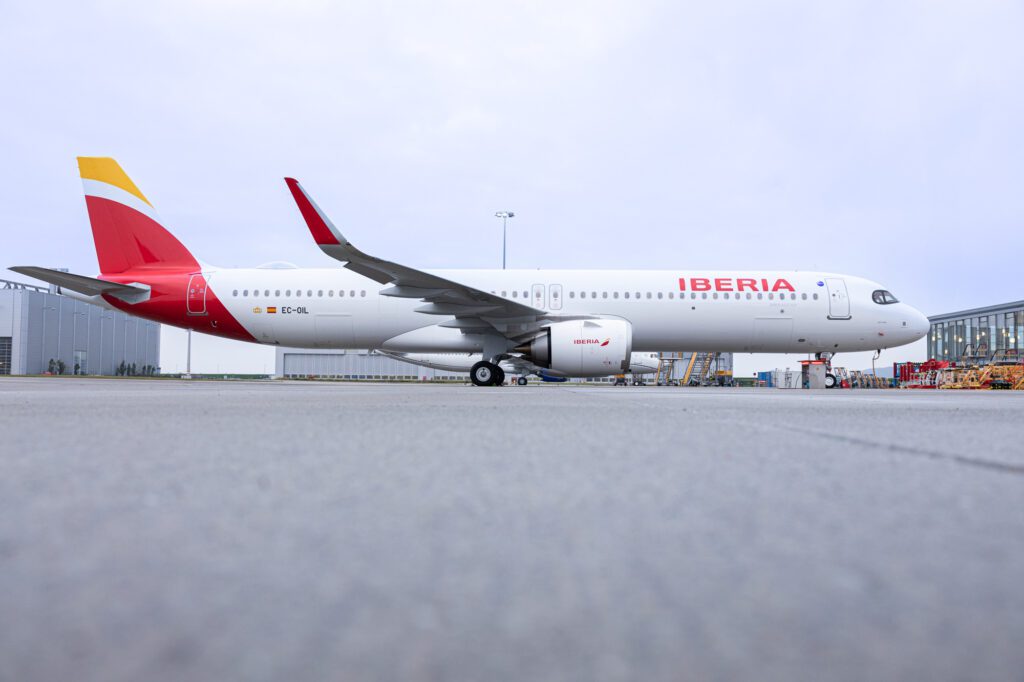
Skift Take
Don’t be fooled by the modest nature of the A321XLR’s Madrid to Paris debut – this plane can fly seriously far with incredible efficiency. Get ready for it to shake-up route networks worldwide.
A seemingly routine flight between Madrid and Paris made aviation history on Wednesday morning. Just after 8:15 am local time, Iberia became the first airline in the world to fly Airbus’ newest passenger airliner.
The A321XLR (that’s Xtra-Long Range) is the company’s flagship single-aisle jet. It builds on the hugely successful A320 program, which is already the cornerstone of fleets at carriers including JetBlue, AirAsia, and easyJet.
The maiden XLR was in the air for a little over 90 minutes on Wednesday, landing in the French capital just before 10 am. The plane will shuttle between the two cities in the coming days for a series of short-haul familiarization flights. These quickly boost the pool of pilots and cabin crew who have worked on the new aircraft and help identify any final snags.
Where Will the XLR Fly Next?
With an enhanced range of 4,700 nautical miles, the XLR is seriously overqualified for a 574nm hop between Madrid and Paris. After its European shuttle period is complete, Iberia will take the jet transatlantic to the United States. Boston is due to be the first long-haul route later in November, with Washington D.C. to follow as more XLRs join the Iberia fleet.
Its impressive range isn’t the only big selling point attracting airlines to the new plane. The XLR has a similar unit cost as traditional twin-aisle long-haul jets. This allows more profitable network expansion on routes that cannot sustain bigger aircraft.
Some future operators, such as United Airlines and Icelandair, are looking to the XLR to replace aging Boeing 757s that are more expensive to run and have poorer environmental credentials.
What’s the XLR Like to Fly?
Each airline will adapt the plane to individual specifications, with many low-cost carriers opting for a dense all-economy layout. For its part, Iberia is staying true to its legacy business model and has configured the XLR with two distinct cabins.
There are a total of 182 seats onboard, including 14 business class ‘mini-suites’ with lie-flat beds. These are not dissimilar to those found on more conventional long-haul widebody planes and offer direct aisle access and 18-inch 4K entertainment screens. The plane has new-generation lighting installed to make the cabin feel more spacious.
The XLR can serve routes of up to nine hours, so enhancements have also been made to the economy cabin.
Its economy seats are an evolution of those found on much larger jets and feature a four-inch recline and leather headrests. Every seat has in-seat connectivity, with the option for customers to connect headphones and other devices via Bluetooth. USB A and C charging is provided and free Wi-Fi messaging is available for all customers, in line with Iberia’s existing long-haul fleet.
A seat map of the Iberia A321XLR is available to view here.
Who Else is Getting the XLR?
Wednesday’s low-key launch was operated by the first of eight XLRs heading to Iberia. The carrier confirmed to Skift that it intends to increase frequencies to existing destinations, as well as expand its network to new locations using the plane. North American destinations will be the focus for aircraft.
Iberia is the first but certainly isn’t the last to welcome the XLR. Aer Lingus – which is part of the same parent company as Iberia – is also due to receive the plane soon. The Irish flag carrier was due to be the launch customer for the aircraft. However, a high-stakes labor dispute with pilots resulted in a late switch.
Latest Airbus sales data shows more than 500 confirmed orders for the XLR. Big names committed to the project include American Airlines, Qantas, and JetBlue. Earlier this year, IndiGo Airlines CEO Pieter Elbers told Skift about his grand plans to link India and Europe with the new aircraft.
Boeing scrapped plans to build a direct competitor to the A321XLR in 2020, leaving the company almost entirely reliant on its troubled 737 Max program.
Watch JetBlue CEO Joanna Geraghty Discuss the A321XLR at the Skift Global Forum 2024:
Airlines Sector Stock Index Performance Year-to-Date
What am I looking at? The performance of airline sector stocks within the ST200. The index includes companies publicly traded across global markets including network carriers, low-cost carriers, and other related companies.
The Skift Travel 200 (ST200) combines the financial performance of nearly 200 travel companies worth more than a trillion dollars into a single number. See more airlines sector financial performance.
Read the full methodology behind the Skift Travel 200.

